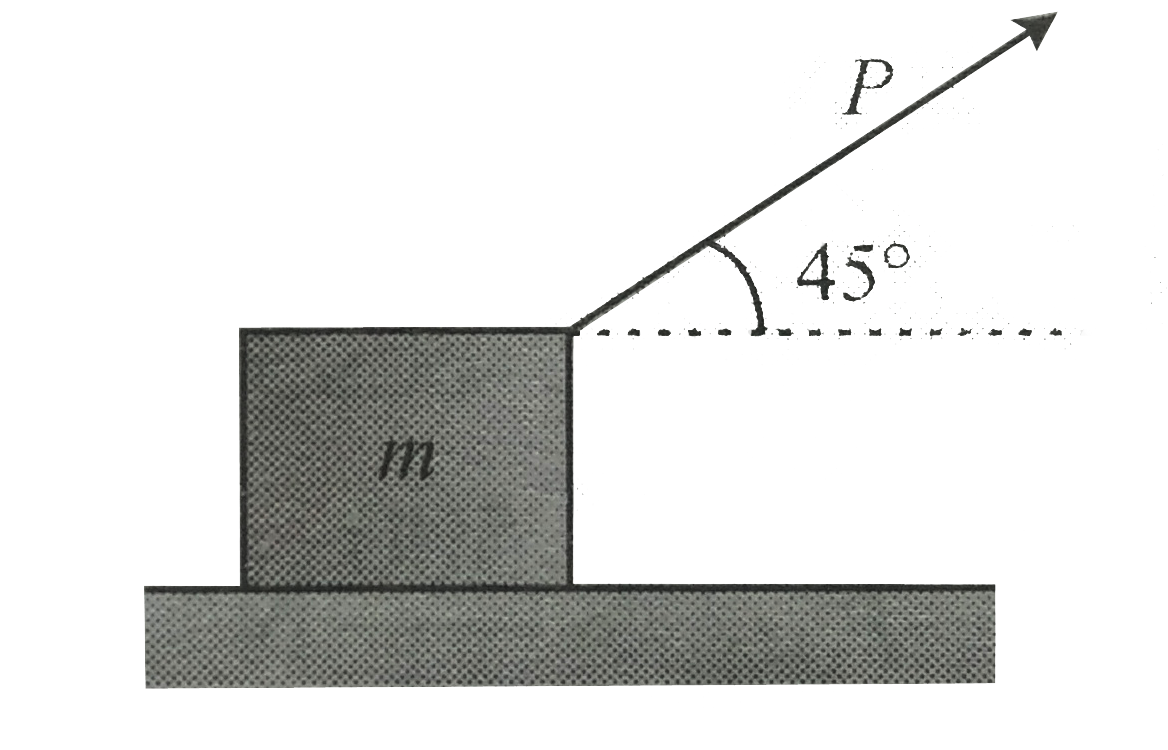A horizontal force of 490 N is required to slide a sledge weighing 600 kg f over a flat surface. Calculate the coefficient of friction.
The correct Answer is:0.083
To solve the problem of calculating the coefficient of friction for the sledge, we can follow these steps:
Step 1: Identify the Given Values
- Horizontal force (F) required to slide the sledge = 490 N
- Weight of the sledge (W) = 600 kgf
Step 2: Convert Weight from kgf to Newtons
The weight in Newtons can be calculated using the conversion factor where 1 kgf = 9.81 N (approximately 10 N for simplicity in some cases).
W=600kgf×10N/kgf=6000N
Step 3: Determine the Normal Force (N)
In this case, since the sledge is on a flat surface and there are no vertical forces acting on it other than its weight, the normal force (N) is equal to the weight of the sledge.
N=W=6000N
Step 4: Use the Formula for Limiting Friction
The limiting friction (F_friction) can be expressed as:
Ffriction=μ×N
Where:
- μ = coefficient of friction
- N = normal force
Since the horizontal force required to move the sledge is equal to the limiting friction:
490N=μ×6000N
Step 5: Solve for the Coefficient of Friction (μ)
Rearranging the equation to solve for μ:
μ=FfrictionN=490N6000N
Calculating this gives:
μ=4906000≈0.08167
Step 6: Final Result
Thus, the coefficient of friction μ is approximately:
μ≈0.0816
Summary
The coefficient of friction for the sledge is approximately 0.0816.
---
- Horizontal force (F) required to slide the sledge = 490 N
- Weight of the sledge (W) = 600 kgf
The weight in Newtons can be calculated using the conversion factor where 1 kgf = 9.81 N (approximately 10 N for simplicity in some cases).
W=600kgf×10N/kgf=6000N
In this case, since the sledge is on a flat surface and there are no vertical forces acting on it other than its weight, the normal force (N) is equal to the weight of the sledge.
N=W=6000N
The limiting friction (F_friction) can be expressed as:
Ffriction=μ×N
Where:
- μ = coefficient of friction
- N = normal force
490N=μ×6000N
Rearranging the equation to solve for μ:
μ=FfrictionN=490N6000N
Calculating this gives:
μ=4906000≈0.08167
Thus, the coefficient of friction μ is approximately:
μ≈0.0816
The coefficient of friction for the sledge is approximately 0.0816.
Topper's Solved these Questions
Similar Questions
A force of 49 N is just sufficient to pull a block of wood weighing 10 kg on a rough horizontal surface. Calculate the coefficient of friction and angle of friction.
View SolutionA force of 98N is just able to move a body of weight 45kg on a rough horizontal surface What are the coefficient of friction and angle of friction ? .
View Solution
Knowledge Check
- Question 1 - Select One
A force of 49 N just able to move a block of wood weighing 10 kg on a rough horizontal surface , then coefficient of friction is
A12B14C16D18 - Question 2 - Select One
A horizontal force of 129.4 N is applied on a 10 kg block which rests on a horizontal surface. If the coefficient of friction is 0.3, the acceleration should be
A9.8m/s2B10m/s2C12.6m/s2D19.6ms2 - Question 3 - Select One
Friction between any two surfaces in contact is the force that opposes the relative motion between them The force of limiting friction (F) between any two surfaces in contact is directly proportional to the normal reaction (R) between them F∝R or F=μR where μ is coefficient of limiting friction If θ is angle of friction then μ=tanθ
A force of 49N is just able to move a block of wood weighing 10kg on a rough horizontal surface The coefficient of friction is .A0.5B4.9C10/49D49/9.8
A force of 98N is just able to move a body of weight 45kg on a rough horizontal surface What are the coefficient of friction and angle of friction ? .
View SolutionFind the least pulling force which acting at an angle of 45∘ with the horizontal will slide a body weighing 5kg along a rough horizontal surface . The coefficient of friction μs=μk=1/3 If a force of doude this is applied along the same direction , find the resulting acceleration of the block
 View Solution
View SolutionA force of 98 N is required to just start moving a body of mass 100 kg over ice. The coefficient of static friction is
View SolutionA 20 kg block is initially at rest on a rough horizontal surface. A horizontal force of 75 N is required to set the block in motion. After it is in motion, a horizontal force of 60 N is required to keep the block moving with constant speed. The coefficient of static friction is
View SolutionFriction between any two surfaces in contact is the force that opposes the relative motion between them The force of limiting friction (F) between any two surfaces in contact is directly proportional to the normal reaction (R) between them F∝R or F=μR where μ is coefficient of limiting friction If θ is angle of friction then μ=tanθ
A horizontal force of 1.2kg is applied on a 1.5kg block which rests on a horizontal surface If the coefficient of friction is 0.3 force of friction is .View Solution

